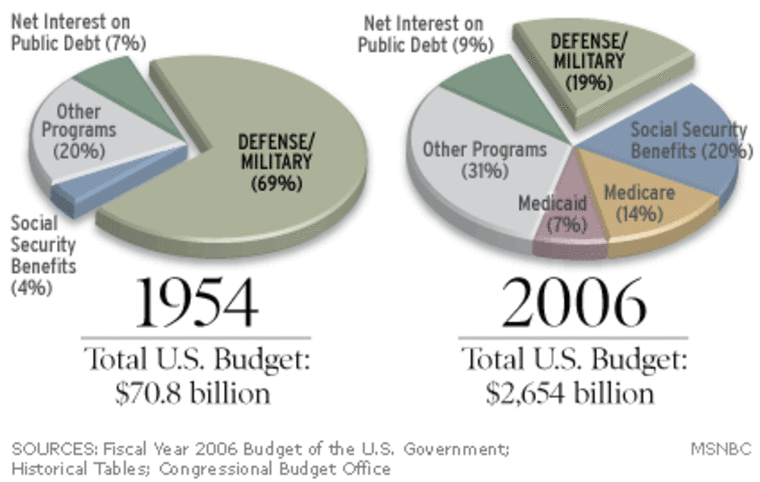You may be asking: “Are you sure you’ve got those pie charts labeled correctly?”
You can see at the top of this story two charts, one depicting federal spending in 1954, the other one showing federal outlays last year.
With wars raging in Afghanistan and Iraq, and on terrorists elsewhere around the globe, the taxpayer last year spent an astonishing amount of money on the military: about $500 billion.
The budget proposal that President Bush unveils Monday won’t ultimately change the size of the slices in that budget pie chart very much.
Spending on the military accounted for 19 cents of every dollar of federal expenditures in 2006.
That might seem like a lot, until you consider the Cold War year of 1954.
The peak of military spending
That year marked the post-World War II peak of military spending, measured as a percentage of total federal outlays.
Nearly 70 percent of all federal expenditures in 1954 went to buy rockets, rifles, radar, and nuclear warheads and to pay the salaries of Americans in uniform.
If you measure it another way, military spending in 1954 accounted for 13 percent of the total U.S. economic output (gross domestic product, or GDP).
Today it accounts for about four percent of GDP, a decline of 70 percent since 1954.
As is often the case in Washington policy debates, everything depends on how you measure: whether in actual dollars, or in spending relative to the total federal budget or the total economy.
What President Eisenhower later called “the military industrial complex” was indeed vast and costly in that peak year of 1954.
In 1954, 3.3 million Americans were serving on active duty in the military. That compares to 1.4 million on active duty today, a 57 percent decline in personnel since 1954.
Cold War nuclear tests
It was a year in which the United States, poised for Armageddon with the Soviet Union, was adding to its nuclear arsenal. In 1954, the United States conducted six nuclear bomb tests and was preparing for another 18 the following year.
In January of that year the Navy launched the first atomic submarine, the Nautilus, at Groton, Conn. In all, the United States had a 730-ship Navy in 1954, compared to the 276 currently “deployable battle force ships”, according to the Navy.
By far the most significant change since 1954 is in the other part of the budget, the non-defense items.
In 1954, the non-military part of the budget was less than one-third of the total; today it accounts for 80 percent of the total.
Take a look at the 1954 chart. Social Security benefits paid to retired workers that year only amounted to four percent of federal spending.
Today Social Security outlays account for 20 percent of federal spending. That amount will grow inexorably larger as the huge generations born between 1945 and 1960 become eligible for retirement benefits.
There’s one telltale sign in the 1954 chart. Neither Medicare, the medical insurance program for older Americans, nor Medicaid, the insurance program for low-income people, existed in 1954.
Congress created those programs in 1965 as part of President Lyndon Johnson’s Great Society.
Soaring Medicare, Medicaid costs
Numbers-crunching Washington guru Stan Collender, author of "The Guide to the Federal Budget", points out that Congress later expanded Medicare and Medicaid beyond their original size.
And “even beyond that, the initial forecasts were wrong. They understated the costs, probably because no one was quite sure how those programs were going to work, they’d never had anything quite like them before,” Collender said.
Today the programs that benefit Americans over the age of 65 — Medicare and Social Security — account for more than one-third of all federal spending. Yet Americans over age 65 only account for 12 percent of the U.S. population.
Medicare and Social Security are called “entitlement programs,” that is, if a person meets the eligibility requirements, he or she is automatically entitled to collect benefits.
“The three largest entitlement programs — Social Security, Medicare, and Medicaid — grow automatically with average wages or health care costs, which generally increase faster than inflation and even the economy overall,” according to a recent analysis from the Washington think tank The Urban Institute. “Thus, these programs, which require no annual renewal, consume greater and greater shares of domestic spending every year.”
'Enormous pressure' on budget
Federal Reserve Board chairman Ben Bernanke warned two weeks ago in testimony to the Senate Budget Committee that “rising entitlement obligations will put enormous pressure on the federal budget in coming years.”
Due to demographic trends — longer life spans and fewer children born to women of childbearing age, compared to 1950s moms — “the number of people of retirement age will grow relative both to the population as a whole and to the number of potential workers,” Bernanke pointed out.
Benefits for older Americans are largely paid for by the tax payments of current workers. Today, there are five people of working age to pay taxes to support each person 65 and older.
According to projections by the Social Security Trustees, by 2030 there will be only three workers for each person over age 65, so the tax burden on those workers will inevitably be heavier than the burden on today’s workers.
Bernanke said unless the entitlement programs are redesigned, federal debt will grow to a point where it “would spark a fiscal crisis, which could be addressed only by very sharp spending cuts or tax increases, or both.”
Senate Budget Committee chairman Sen. Kent Conrad, D-N.D., is also sounding the alarm.
“We’re heading for a circumstance in which all of federal spending will be consumed just by Medicare and Medicaid and Social Security,” Conrad said Thursday. “There’d be nothing left for national parks, for highways, etc. That’s the outlook in the long term, if we fail to act. The conclusion one reaches is that we’re on a completely unsustainable course.”
Such a dismal scenario might make one nostalgic for 1954.
